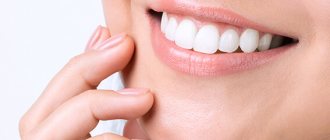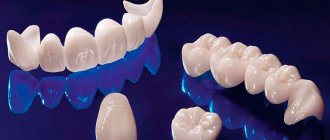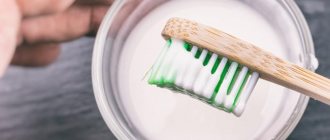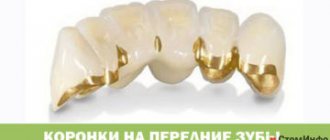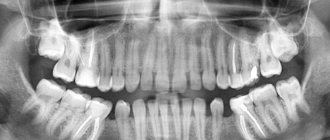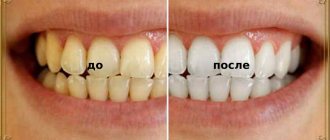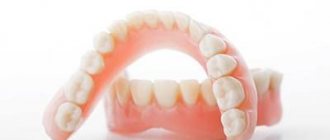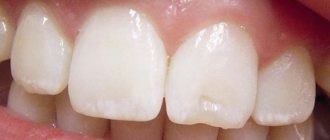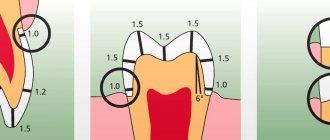How to organize care for metal-ceramic teeth?
Metal-ceramic crowns and bridges (fixed structures) are the most popular type of prosthetics.
Patients choose metal-ceramic dentures because of their strength, durability and reliability. The products can withstand high loads, have good aesthetic characteristics, and practically no plaque accumulates on their surface. Products made of metal ceramics do not require any special care, as they are durable, their surface is so smooth that they do not accumulate plaque. Care for metal-ceramic teeth must be organized in the same way as for natural teeth, the main thing is to do it regularly and efficiently.
You can clean metal-ceramic teeth with a regular brush.
Metal ceramics do not require a special diet, but you should not test its strength (opening bottles with your teeth, gnawing bones, etc.). Due to such experiments, the ceramic layer may chip, after which the prosthesis will have to be repaired or replaced.
It is also necessary to remember that there is a living tooth under the crown. It is important to prevent food from getting under the crown. Yes, this is possible even with modern technologies that make it possible to produce dentures that fit perfectly to the ground tooth and gum.
Expert opinion. Dentist Ovchinnikov P.Yu.: “The gums are very pliable, so when chewing food, pieces of it can easily push away the mucous membrane and get stuck between the gum and the denture. Over time, inflammation, swelling, and soreness will occur. For this reason, a small distance is specially left between the gum and the crown - a rinsing space. This gap allows the usual rinsing to clear out food that is stuck there.”
Despite the fact that metal-ceramic teeth do not require special care, they must be cleaned daily and thoroughly, this is the only way to be sure of a long service life of the prosthesis without unpleasant surprises. Simple but effective recommendations for caring for dentures:
- crowns must be cleaned using vertical sweeping movements from the gums to the cutting edge,
- choose a brush with soft bristles so as not to injure the mucous membranes,
It is recommended to use an irrigator.
If possible, buy an irrigator. This is a special device that creates a thin stream of water under high pressure, washing away plaque and food debris from the most inaccessible areas. The irrigator also provides effective massage of the gums, cleanses the tongue and mucous membranes.
Plastic dentures. care features
Not everyone has the opportunity to install expensive metal-ceramic teeth. An alternative in this case is budget plastic. This material is quite reliable and is able to maintain its original whiteness throughout its entire service life with proper care.
But the question of how to whiten plastic dentures arises when eating foods that have coloring properties. Smoking leaves its mark plus bad breath.
To remove plaque, special products are offered - Protefix, Corega, Rox. On average, once a month, the tablet is dissolved in water and a removable plastic structure is placed in the resulting solution for the time specified in the instructions. This procedure allows you to preserve the shade and extend the service life.
You can solve the problem of how to whiten dentures by contacting a specialized clinic. Specialists will select the necessary products to restore color.
Durability of cermets
When choosing prosthetics, the patient is guided by the durability of the material and its aesthetics. Metal-ceramics corresponds to these qualities, but it cannot last forever, losing its original appearance.
Considering the fact that a metal-ceramic prosthesis has a ceramic coating, and the main frame is made of metal, the service life of the structure is calculated from the wear resistance of the metal subjected to chewing load.
Metal ceramics are durable
The service life of the metal frame reaches 12 years. The frame is made of gold and platinum upon individual order, which increases the service life to 15 years. Using dentures in accordance with the dentist’s recommendations allows you to extend their service life.
Teeth whitening with tea tree oil
| High-quality whitening can be carried out only with natural essential oil of 100% concentration. First, carry out regular teeth cleaning using a toothbrush and toothpaste. Then apply 2-3 drops of essential oil to the brush and distribute it over the surface of the tooth enamel. Numbness of the cheek or part of the tongue is a side effect of the procedure, after which the oral cavity is thoroughly rinsed. Cleaning enamel with tea tree oil will remove not only plaque, but also tartar. |
- Teeth hurt after whitening: what to do if you have sensitive teeth
- Whitening teeth with thin enamel
- Teeth whitening without harm to enamel
- Teeth whitening without removing enamel
Caring for metal-ceramic teeth: basic rules
In this article, we will look at the stages of caring for metal-ceramic teeth. The most popular type of prosthetics today is, of course, crowns. But why is this so? The thing is that such structures, even after a long time, cannot darken, will not wear off, and, moreover, on some systems plaque does not accumulate at all, as on ordinary natural chewing elements.
No one is saying that a person who has installed such systems for himself should forget about them altogether and not take care of them in any way. It is imperative that such structures also require full care, different from that provided for natural teeth. This is not difficult at all and does not cause any difficulties, and most importantly, you need to observe the regularity of these procedures and the correctness of their implementation. This option will extend the life of such products significantly.
| Video (click to play). |
Metal-ceramic dentures are becoming increasingly popular because... have certain advantages compared to other prostheses, namely:
- reliability;
- practicality;
- aesthetic appearance.
But it is also worth remembering that they require careful treatment, daily care and periodic intervention by specialists (dentists, dental laboratory workers). The prosthetic procedure is quite lengthy, so you should have a lot of patience.
Note: After making a custom prosthesis, it takes some time to completely get used to it.
You may need to visit your dentist several times to have your finished product adjusted. There are rarely cases where a prosthesis fits perfectly and does not require any additional adjustment.
In this article you will find the answer to the question: “How to properly care for metal-ceramic teeth?”
By following these simple rules for caring for metal-ceramic teeth, you can always keep your teeth in order, and your smile will be the most irresistible and attractive!
Patient's review of basal dental implantation with immediate loading of the prosthesis
How to install metal-ceramic crowns
The duration of prosthetics – from turning to placement of the structure – is about 10–14 days. Before placing a prosthesis, the dentists of our clinic determine the presence of contraindications to the procedure and conduct thorough therapeutic preparation of the oral cavity.
The process of installing metal-ceramic crowns begins with an x-ray, through which inflammatory processes can be identified and, if necessary, eliminated by filling the canals. If there is inflammation in the oral cavity, the doctor performs pulp removal. Nerve removal is also carried out in single-rooted teeth and, if indicated, in multi-rooted ones.
In the case when the coronal part is destroyed, it is re-formed. To do this, a stump tab or a special pin is inserted into the root canal to strengthen the tooth before placing a metal-ceramic crown on it. Next, a filling material is used, which will later be ground and covered with the structure.
Installation steps
The process of installing a prosthesis includes several stages:
- Tooth turning. The amount of dental tissue that needs to be ground is determined based on the width of the future frame.
- Taking impressions. After grinding, the orthopedic dentist makes a plaster model of the tooth and transfers it to the dental laboratory, where a metal-ceramic crown is made.
- Installation of temporary crowns. While the permanent structures are ready, temporary dentures are placed on the dentition. This is necessary so that the ground teeth are not subject to destruction due to external influences. In addition, temporary products perform an aesthetic function if they are on the front teeth.
- Fitting. After making the frame, the dentist tries it on and then veneers it with ceramics. Next, the product is tried on again.
- Prosthetics. When a metal-ceramic crown on a tooth meets all the required parameters, it is secured in the oral cavity with permanent cement.
Caring for metal-ceramic teeth - how to care for dentures at home?
Each fragment is made from an impression taken of the patient's tooth or jaw to create a structure identical to natural teeth. Regardless of the installation of a single crown or complete jaw prosthetics, the patient must observe the rules of oral hygiene.
Denture hygiene does not require any procedures; you just need to brush your teeth in the morning and evening. Throughout the day, dentists recommend brushing your teeth, flossing, and rinsing your mouth after eating.
It’s easy to care for dentures yourself; all you need to do is:
- Use a toothbrush with soft bristles that will not disturb the ceramic layer and will not irritate the gums.
- Clean your teeth using a brush, pressing it against your teeth and moving it horizontally. Clean the gaps between the teeth by moving the bristles of the brush in the direction from the gums to the edge of the tooth.
- Once brushing is complete, floss is used.
Do you feel nervous before visiting the dentist?Not really
- Rinse with an irrigator. The irrigator allows you to replace dental floss or eliminate it during deformation or damage to the denture. The solution cleans teeth, crevices between them, and gums from plaque and food debris. The components included in the composition improve blood circulation in the gums and tone them.
- Gum massage sounds unusual, but the procedure after cleaning is necessary to keep the gums in good shape, which is more necessary than with your own teeth. In case of inflammatory processes of the gums, the procedure is contraindicated.
After installing crowns, patients may experience pain, which requires them to consult their doctor. Such signs occur when caries reoccurs or when a damaged tooth under the crown is not treated sufficiently.
Improper oral care leads to loss of dentures. To preserve the pristine whiteness of your smile, you must:
- brush your teeth with a brush and toothpaste or cleaning powder, perform the procedure twice a day;
- Clean the spaces between the teeth with floss and use mouth rinses;
- bridges require cleaning the channel between the metal-ceramic structure and the gum;
- Ceramic coating is not resistant to dyes, so it is recommended to reduce the consumption of foods and drinks containing this component.
Patients need to make differences in the care of dentures: permanent and removable. Crowns and fixed bridges require cleaning procedures before going to bed.
Removable bridges - should be removed before going to bed at night and stored in a container with a solution. It is possible to clean with drying and storing in a clean place until waking up.
Whitening
Owners of metal ceramics cannot count on the effect of whitening products. Any bleaching procedures are useless for this species.
Whitening is a useless procedure for metal-ceramic crowns
Ultrasonic cleaning
Dentures require special cleaning to remove hard plaque, leading to regular visits to the dentist for ultrasonic cleaning.
We invite you to read: Benefits of children's dental trainers
Contraindications
Not every situation is worth resorting to prosthetics. Small teeth, malocclusion, loss of most of the teeth - dentists will offer to correct all this.
The procedure cannot be performed if:
- inflammation of the oral cavity;
- weakening of the immune system;
- frequent colds and exacerbations of diseases;
- pregnancy;
- osteoporosis.
Many patients sooner or later go to the dental office for dental prosthetics. Today there are many different prostheses available. Metal-ceramic prostheses are very popular. Let's look at how to care for metal-ceramic teeth.
Prostheses in the form of bridges and crowns are made from metal ceramics. They are made by spraying or casting a layer of ceramic onto a metal base.
Metal-ceramic products are excellent for replacing molars. For whom it is not so much appearance that is important, but rather functionality. A bridge can also be made from this material.
In most cases, metal-ceramic dentures are used to replace teeth that perform an active chewing function. And it doesn’t matter whether it’s a separate crown or a bridge.
Metal-ceramic dentures are very durable and can cope with any food, even hard ones. But don’t forget that this is still a prosthesis, which means you need to be careful with it and not conduct experiments, such as cracking nuts.
Dentists note that the strength of such structures is high, but not infinite.
Some patients are mistaken in believing that a metal-ceramic crown will last the rest of their life. Despite the strength and wear resistance, even the operation of this type of product has limitations.
Metal-ceramic dentures, which are based on simple metal, last approximately 10 to 12 years. If an alloy of gold and platinum was used for the frame, the service life will be 15 years, and sometimes more.
The service life of a metal-ceramic prosthesis, like any other, largely depends on the correctness of its manufacture and the patient’s compliance with all the rules for the care and use of this design.
Let's look at how to care for metal-ceramic dentures:
- Clean the mouth at least twice a day.
- Disposing of leftover food after every meal, including snacks.
- It is advisable to avoid the use of nicotine, tea and coffee, which can leave unpleasant stains on dentures.
- Regular visits to the doctor to remove the plaque that has formed.
- Regularly remove structures at night, placing them in a special solution, or leaving them dry.
- Avoiding exposure to too high and low temperatures, as well as their changes.
- Do not try to chew hard foods, open bottles with your teeth, etc., which causes a lot of stress and can damage the prosthesis.
When caring for metal-ceramic dentures, proper cleaning is very important.
Let's consider its basic rules:
- A specialist can recommend the most suitable brush for a patient who has had metal-ceramic dentures installed. The softness of the bristles is not particularly important. When cleaning, move the brush in different directions. In the case where there are several such structures in the patient’s mouth, when choosing a paste, doctors recommend compositions containing herbs or propolis.
- It is also advisable to use floss, which will rid hard-to-reach areas of food particles.
- After each cleaning, it is recommended to rinse your mouth with a special composition, which can also be recommended by a specialist.
- In order to protect yourself from bad breath, you should pay special attention to the rinsing channel when cleaning.
- In addition to floss, it is recommended to use toothpicks, brushes and other devices to clean the spaces between teeth.
- You should not let the resulting plaque build up. It should be removed as soon as possible through professional cleaning at a dental clinic.
It happens that a patient carefully performs oral hygiene, but bad breath still appears. The cause may be the patient's general diseases, and not problems with the oral cavity. In such a situation, dentures can be cleaned using pharmaceutical products recommended by a doctor, as well as traditional rinses.
Let's consider the main folk remedies:
- Add a tablespoon of crushed oak bark to a glass of boiling water, then cook for 30 minutes.
- Mint infusion. You can use dry (one cup) or fresh (20 leaves) grass. Half a liter of boiling water is added to it and infused.
- Chamomile infusion, which is very popular in all areas of traditional medicine. One handful of dried chamomile is poured into a glass of boiling water and left to infuse.
Thus, to prolong the life of the prosthesis, you need to properly care for it, as well as use the right food.
Careful treatment of artificial teeth, which, by the way, often contain living teeth, and their correct use will significantly increase their service life.
Video review from a patient about implantation and prosthetics against the background of advanced periodontitis, in 3 days!
After prosthetics with metal-ceramic implants, a problem arises over time - the prosthesis darkens and loses its presentable appearance. Another difficulty is that my teeth have become darker in color than the denture.
Many people decide to undergo a lightening procedure and restore their smile to its original appearance. But the answer to the question whether it is possible to whiten metal-ceramic teeth does not satisfy everyone.
Dentists have come to the conclusion that it is impossible to whiten metal-ceramic teeth perfectly. Ceramics are considered a very hard material, so virtually no brightening material will affect it.
Ceramic crowns can be whitened using a staining procedure. For this purpose:
- enamels;
- professional dental paints;
- varnishes.
The most commonly used paint is Dental Paint. This product allows you to paint any, even the most difficult to reach areas. Suitable for working with fillings, dentures and crowns. The color becomes 10 shades whiter than the original and looks natural. The result is quick but temporary. The advantage of paint or varnish is that there is no need for polishing and no additional maintenance is needed.
Painting, unlike other manipulations, is considered the most ineffective. This process is similar to applying makeup, which is washed off daily; the color will come off immediately after brushing your teeth. Also, these whitening materials, when used frequently, lead to the destruction of the crown or filling.
Electrosonic cleaning is considered an effective and painless procedure. The entire process takes no more than 20 minutes.
The procedure includes several stages:
- Ultrasonic cleaning of tooth enamel from stones.
- Polishing with brushes and special toothpaste.
Advantages of such cleaning:
- Plaque is completely eliminated, micropores are cleaned of bacteria, and stone is removed;
- serves as a prophylaxis against periodontitis and caries;
- low cost.
Since ceramic material is not stained or whitened, it is better to lighten your teeth in advance, even before dentures.
Features of metal-ceramic crowns
A metal-ceramic crown is a dental structure consisting of a metal frame and a ceramic shell.
Visually, it looks like a cap that is put on the tooth and exactly repeats its natural shape. The metal-ceramic crown is fixed using composite or glass ionomer cement. If the fabrics are too damaged and do not allow the structure to be fixed, a metal insert is used as a base. Unlike other types of dentures (metal or metal-plastic), metal-ceramic completely reproduces the natural shade of the tooth surface and does not change its color over time. If you look at the photo of the jaw after prosthetics, you will notice that the metal-ceramic crown has no differences from natural teeth.
The ceramic part of the product is based on carbides, oxides, carbon and silicides, which do not contain toxins and do not pose a health hazard. During the manufacturing process, ceramics are applied manually and subjected to constant firing, so they become highly resistant to external influences and, with proper care, retain their attractive appearance even after a decade. At the same time, it is very important to choose a competent orthopedic dentist who will produce a reliable product that meets modern requirements and standards.
When installing metal-ceramic crowns at the Telo's Beauty clinic, patients can count on high quality services and an affordable cost of the procedure. To get durable metal-ceramic crowns, contact our center in Moscow by phone listed on the website.
The effectiveness of metal-ceramics has been proven in the restoration of both lateral and anterior teeth. It is used with equal success for the restoration of one tooth and for the manufacture of bridges designed to replace an entire section of the dentition. If over time the patient requires repairs to the structure, then small chips on its ceramic part can be repaired directly in the mouth - without removing the denture.
Is it possible to paint metal ceramics?
It is not always possible to completely eliminate foods containing dyes from the diet and carry out thorough cleaning - and this means a quick loss of the whiteness of metal ceramics. Varnishes and enamels, as well as specialized paints, will help replenish the lost effect of the “Hollywood smile”.
Highlighting painting among other methods, it is worth noting that it is less effective:
- the effect is short-term, its effect is similar to daytime makeup, which is washed off in the evening. Only in the case of paint, it is removed during the first cleaning;
- It should not be forgotten that the increased fluoride content not only has a whitening effect, but is also destructive to crowns.
How to keep your teeth healthy when whitening
Complying with all safety standards is not enough; whitened teeth require increased care:
- Monitor oral hygiene daily, at least 2 times a day;
- give up coloring foods (coffee, tea, wine, berries) for a week;
- refrain from smoking;
- eat right, eat more fresh vegetables and fruits, dairy products;
- visit the dentist 2 times a year for preventive examinations;
- to strengthen dentin, use professional pastes with fluoride and calcium: Vivax Dent, Elmex, Lacalut alpin, etc.
Our advice is to choose the laser method as the least traumatic. An alternative option is to use home systems that your dentist will select individually for you.
| After a course of teeth whitening at home, the result can last from several months to a year, of course, subject to making some changes to your usual diet. Then the enamel gradually loses its whiteness, becomes yellow or brown, and the course must be repeated. Professional whitening keeps teeth snow-white from six months to three years, if all precautions are taken in the first days after the procedure. But teeth whitening in a dental office using AirFlow abrasive technology or acidic chemical compounds has more contraindications. Another significant drawback of such procedures is that teeth can become hypersensitive for several weeks, which makes eating hot, sour and sweet foods, drinking tea and even breathing in cold weather unbearable due to painful sensations. |
How to properly care for metal-ceramic teeth?
Metal-ceramic bridges and crowns are the most popular today. Many people prefer them because of their reliability, durability and strength. Such devices can withstand heavy loads, are beautiful to look at, and also have a surface on which plaque does not accumulate.
To increase the life of devices and protect the oral cavity from bacteria, it is necessary to take care of metal-ceramic products.
Such products are quite durable and do not accumulate plaque on their surface, which does not require special hygiene procedures. You should clean metal ceramics in the same way as regular teeth. But this needs to be done efficiently and regularly.
We suggest you familiarize yourself with: Burs for preparation for metal-ceramics
When wearing metal-ceramic structures, you do not need to adhere to a diet. But strength testing of structures should also be abandoned. Such experiments can have negative consequences. We must also remember that under the crowns there are teeth, which should not be touched by food debris.
If you do not properly care for metal-ceramic structures, they can lose their attractive appearance in a short time. Their surface will darken, so artificial teeth will require the same care as real teeth. Those who wear such devices must:
- Brush your teeth with toothpaste twice a day.
- Remove food debris after meals using dental floss.
- Rinse your mouth after eating with antiseptic solutions.
- Clean the area between the structure and the gums.
- Avoid eating foods and drinks that can change the color of your artificial tooth.
When a person goes to bed, it is recommended to remove such devices. They can be stored in special containers. If the structure is not removable, then you just need to rinse and clean it.
Metal ceramics can change their original color due to constant consumption of food and drinks with dyes, as well as due to improper oral care. Today there are special solutions, paints and varnishes that will help restore the attractiveness of a smile and whiten the structure. But the use of such means is not always justified. This happens for the following reasons:
- The coloring effect will not last long.
- A large amount of fluoride in such preparations can negatively affect the crown.
If a person wears an artificial prosthesis, regardless of the material it is made of, then he should remember that it is impossible to bleach it on his own. To care for metal-ceramic dentures, you need to regularly clean the structure at the dentist using professional methods. The most common method is electrosonic cleaning.
Home whitening methods can only be used on natural enamel, so it is recommended to carry out such activities before starting prosthetics. Then the doctor will choose a crown that is similar in color to your natural teeth.
Whitening strips are an aggressive method. This method has certain contraindications, which you must first familiarize yourself with. Using such devices, you can only clean natural enamel. The strips will not be effective in whitening artificial teeth.
You can use regular toothpaste to clean artificial teeth. It is recommended to choose products that do not contain abrasive particles, have a mild effect and care for the gums. You can also choose herbal pastes.
The choice of one toothpaste or another depends on a person’s preferences. You can also consult a dentist about this, who will recommend the optimal remedy for a particular type of teeth. Preference should be given not to expensive, but to high-quality pastes. It is also important to brush your teeth properly.
These devices are the most convenient to use. But their effectiveness is low when compared with other methods. Whitening is carried out with a special felt-tip pen or a product from a bottle with a brush. You can use this method before a date or an important meeting. When brushing your teeth, the dye is washed off.
Metal ceramics can be cleaned using chemicals. To do this, use tablets that contain enzymes and components for disinfection. This helps to effectively remove plaque from crowns and clean their surface. To clean, place the crowns in a glass of water in which the tablets were previously dissolved. The structures need to be kept in the liquid for 10-15 minutes.
Baking soda is often used to clean cermets. But this technique may not always have a positive effect on the prosthesis material. Soda contains abrasive particles that can damage the records. If soda is used for cleaning, then it should be applied to the crowns in a small amount and not apply force when cleaning.
To prepare the solution you will need:
- Spoon of soda.
- 1 egg white.
- 5 milligrams of milk.
All these components should be thoroughly mixed. The results of cleaning will be noticeable immediately. But you can’t brush your teeth often with this composition. A more gentle cleaning method is to use olive oils.
Even though crowns are made of artificial material, they will also require constant care to maintain the attractiveness and whiteness of your smile. You need to take care of your crowns every day. When wearing crowns, you should follow these recommendations:
- Don't eat anything solid.
- Do not overuse cold or hot.
- Be constantly examined by a dentist, especially if discomfort in the mouth occurs.
If you properly care for artificial metal-ceramic crowns, they can last for decades. To avoid any unpleasant surprises with dentures, you should follow these recommendations:
- Clean with vertical movements.
- Choose a brush with soft bristles.
- It is recommended to use pastes based on herbal extracts.
- Use dental floss to clean between molars.
- Use disinfectant solutions to rinse your mouth after eating.
- Smokers and coffee drinkers who wear metal-ceramic dentures need to have their structures regularly cleaned by a dentist.
If possible, it is recommended to purchase an irrigator. This is a device that can create a jet of water under pressure. With its help you can clean your teeth from plaque. The water jet also massages the gums.
As you can see, even artificial teeth require constant care. For crowns to last a long time, you just need to follow your doctor’s recommendations and brush your teeth regularly.
Lightening filled teeth
It should be noted that teeth whitening with fillings has its own specifics. Experts note that during this procedure the shade of the filling material cannot be lightened. This leads to the appearance of unaesthetic stains that stand out against the background of bleached enamel, which is especially noticeable if the patient has a filling on the front tooth that is exposed to view.
Whitening is allowed for small fillings. If they are extensive, then the installation of modern ceramic veneers is recommended as an alternative.
If the dentist decides to carry out bleaching in the presence of fillings, then it has the following sequence:
- at the first stage, it is necessary to clean the dental surfaces from stone, plaque, and compressed deposits;
- then follows the bleaching procedure itself using professional techniques - chemical, mechanical, light;
- at the final stage, according to indications, the restoration of old fillings usually follows, which must be replaced with the selection of a color corresponding to the resulting shade of enamel.
If there is a slight plaque, you can use some tips showing how to whiten a filling at home.
- Several times a day, hold a cotton swab soaked in lemon juice on the problem area for 15 minutes.
- Mix 20 drops of hydrogen peroxide with ammonia (2 drops). Apply directly to the filling. With high-quality material, a positive result is already visible by the fifth day.
- Twice a week, instead of toothpaste, sprinkle soda on a damp brush. This procedure produces a whitening effect on the surface of the tooth.
The same techniques are optimal if there are extended teeth. The material used is identical to fillings, and initially it is selected in accordance with the shade of the enamel.
We suggest you read: Can thrush in the mouth be transmitted?
Without consulting a dentist, you do not need to whiten your teeth at home, since teeth must be free of disease to achieve the effect. A contraindication to this procedure is any inflammatory process that develops on the gums. Manipulations with lightening during pregnancy are not recommended.
Whitening methods
Some methods will help achieve a certain effect:
- Special stripes. Whitening strips are very rarely of the appropriate quality, so before using them, you need to study the composition and contraindications on the packaging. Dentists do not recommend using them to clean dentures.
- Pastes and gels. They are used for cleaning, referring to the quantitative ratio of dentures and their teeth. If you have more teeth, then you should choose a suitable remedy for them. If you have a large number of crowns and bridges, you should avoid cleaning products containing abrasive components: fluoride, calcium.
- Pencils. Pencils and correctors are suitable for creating a short-term whiteness effect. Such funds help out before an important event, when you need to get an immediate effect.
- Soluble tablets. Tablets with a special composition of disinfectants effectively clean removable dentures. To use, you need to dissolve the tablet in a bridge storage vessel and leave it in it for a quarter of an hour.
Indications
Metal-ceramic dentures are installed on real teeth or, if they are missing, on implants. In any case, the following indications exist:
- Defect of existing crowns. For example, the crown became deformed, the shine was lost, and the color changed greatly.
- Destruction of crowns. That is, complete destruction of the outer shell of the tooth has occurred and it is simply impossible to restore it with the help of dental inlays or fillings. The characteristics of the disease do not allow it.
- Defects of the entire dentition.
- The patient has pathological abrasion of the covering of the teeth.
- The need to restore chewing function and natural teeth.
- Inconsistency of existing dental structures with aesthetic requirements. This can be said about bridges, plastic crowns, metal crowns and combined devices.
- There is a need to restore two or more teeth with a dental bridge.
- Anomaly of tooth growth, when other methods of eliminating this defect are unacceptable.
You should not use metal ceramics if:
- The patient has a clearly expressed or may experience an allergic reaction to the implanted structure.
- The patient's crown part of the tooth is shortened.
- Convergence of teeth is observed.
- You cannot place metal-ceramics on a diseased tooth. It must first be completely cured.
- If the patient grinds his teeth at night (bruxism).
- Periodontium is visible on the teeth.
- There are obvious defects in the dentition over a long distance.
Is it possible to whiten metal-ceramic teeth and how to care for them?
It is very difficult to whiten metal-ceramic teeth; ordinary paints, varnishes, and bleaches will not give a long-term positive result. The only reliable option is the installation of veneers.
Veneers are the most aesthetic and fastest method of teeth whitening. If a high-quality installation is carried out, this plate will last at least 15 years, and with professional care it will retain its presentable appearance.
The procedure is carried out quickly, in several visits to the doctor. The patient is given the opportunity to independently choose the color so that the smile looks as natural and natural as possible.
Expensive, but high quality and beautiful!
To get rid of yellow plaque at home and slightly whiten ceramic teeth, you can use the following means:
- A pencil is a tube containing whitening gel. At the end of the pencil there is a soft brush, sponge or brush for applying the product. It is necessary to apply the gel morning and evening. The course lasts 14 days.
- Lightening tablets - the drug dissolves in water. Then the prosthesis is lowered into a container with liquid for 20 minutes. This procedure provides antibacterial protection and qualitatively whitens the metal-ceramic structure.
- Special strips are not recommended for use in prosthetics. If you still decide to use whitening strips, it is important to follow the instructions and study the composition.
- Toothpaste. It is necessary to choose the type that contains calcium and fluorine. After cleaning, you can massage the gums to stabilize blood circulation.
There is an alternative medicine recipe that can be used in lightening and caring for metal-ceramic teeth. Components:
- chicken egg white – 1;
- baking soda – 1 teaspoon;
- mint – 2 grams;
- milk - a teaspoon.
We suggest you read: Is it possible to whiten artificial teeth?
All ingredients are mixed and applied to tooth enamel and implants. After a few minutes, your mouth will rinse. Due to the soda, it is not recommended to use this method often.
To keep your ceramic teeth looking good, you need to know how to care for them. It is important to do this regularly.
To care for removable metal-ceramic structures, you need to have a special container and liquid for cleaning and bleaching.
You need to care for fixed dentures made of metal ceramics a little differently. The main thing is to clean them regularly. With fixed dentures, the artificial tooth is cleaned with a brush and paste, movements should be from top to bottom. The brush is selected depending on personal preferences, sensations and condition of the gums.
If metal-ceramic bridge structures are installed, you need to clean the rinsing channel, which is located between the gum and the artificial tooth. This will eliminate the unpleasant odor. The process is carried out with a regular medical syringe without a needle or an irrigator.
Precautions when caring for metal-ceramic teeth:
- Do not eat hot or cold foods: the integrity of the structure deteriorates and yellowness appears on the enamel.
- Drink less black tea and coffee, as these drinks are coloring products.
- It is forbidden to chew hard foods, crack nut shells with your mouth, or crack seeds. This leads to scratches and splits.
- Get checked by a dentist in a timely manner.
Today, metal-ceramics is considered one of the most popular materials for prosthetics in dentistry. Its main advantages are high strength and durability, decent aesthetics and affordable cost. However, in order for prosthetics to be truly durable and reliable, the patient should know how to properly care for metal-ceramic teeth and carry out such care regularly.
Despite the fact that caring for metal-ceramic teeth is quite simple and does not require any special effort, it should be done daily, regularly and carefully - only in this case the patient can be sure that the structures will last a long time and will not cause problems. The basic rules of care are:
- You should brush your teeth at least twice a day, using vertical sweeping movements in the direction from the gums to the cutting edge of the teeth.
- It is better to use a brush with soft bristles that will not injure your gums. You can use the most ordinary toothpaste, but in cases where most of the dentition in the mouth is replaced by dentures, it is better to choose toothpastes that care for the gums (containing herbal extracts or propolis).
- You can’t limit yourself to just cleaning, since you need to care for metal-ceramic crowns just as carefully as you take care of your “natural” teeth, so after each cleaning, the interdental spaces are cleaned with dental floss.
- After cleaning, you should rinse your mouth thoroughly - first with water, and then with an antiseptic solution, which the dentist will recommend.
- If a person smokes, often drinks coffee or other staining and plaque-creating drinks and products, it is necessary to regularly carry out hygienic cleaning at the dentist, since caring for metal ceramics only at home will clearly not be enough. Whitening pastes do not affect artificial teeth and therefore will not give any effect.
Dentists recommend that patients who have metal-ceramic bridge structures installed do not forget to thoroughly clean the rinsing channel located between the crown and the gum during hygiene procedures - if this is not done, food debris will accumulate and gradually decompose in the channel, and bad breath will appear .
The main misconception of patients who do not know exactly how to properly care for metal-ceramic teeth is that they consider artificial teeth to be stronger than natural ones. As a result, a person may try to chew nuts or eat food that is too cold or too hot.
In addition, many people believe that plaque cannot form on metal-ceramic crowns in principle and therefore it is not necessary to clean them too thoroughly. This is not true - when consuming certain foods and drinks, as well as smoking, plaque still forms, and it is better to remove it in the dentist's office during regular hygiene measures (about once every six months to a year).
Also, we must not forget about regular medical examinations every six months in order to promptly identify and eliminate possible problems with prosthetics. I invite you to a free examination at the dental office.
In his life, a person sooner or later is faced with the fact that his tooth cannot be restored. This is why dental implants were invented, which will preserve the aesthetic beauty of a smile and also allow you to chew food without discomfort.
Most often, metal-ceramics are used to make dentures, since it is similar in color to natural teeth, and it is also a high-quality material that is resistant to various irritants, which can be caused by hot or hard foods.
Installing dental implants is the best way to restore missing teeth. The patient is given options for materials from which the denture can be made, but the most optimal of them is metal-ceramics.
It is worth noting that implantation is a full-fledged operation, which for some time irritates the entire oral area, especially those areas where it directly occurred. Therefore, it is considered mandatory to know how to care for metal-ceramic teeth.
Caring for metal-ceramic teeth involves following the instructions of the attending physician. In the period after surgery, the oral cavity is more vulnerable to infections because surgery involves various incisions and subsequent suturing of small wounds. First of all, it is important to observe basic hygiene standards especially carefully during this period.
In the postoperative period, medications are prescribed that help quickly get rid of the unpleasant consequences of prosthetics. This can also be regarded as oral care after dental implantation.
After surgery, local side effects appear:
- slight swelling of the facial tissue. It is noted that it is of an individual nature.
- blood in saliva. A small amount of blood, the so-called ichor, may be observed for several hours.
- hematomas. Due to irritation, small hematomas and bruises appear. This is a common occurrence that goes away within a week.
- aching pain accompanies the patient for several days after surgery.
Based on this, the attending physician prescribes a list of medications in order to alleviate postoperative consequences and restore damaged tissues of the oral cavity:
- Amoxiclav is a broad-spectrum antibiotic that prevents the inflammatory process caused by surgery.
- "Linex" is a probiotic that is prescribed along with an antibiotic in order to avoid diseases of the gastrointestinal tract that can be caused by taking antibiotics.
- "Suprastin" is an antihistamine drug that, like an antibiotic, prevents the spread of the inflammatory process in the oral cavity after prosthetics.
It causes drowsiness, so it is recommended to refrain from driving during treatment.
- Nurofen is an anti-inflammatory drug that also has an analgesic and mild antipyretic properties. As a rule, it is prescribed in the form of tablets.
- "Calcemin" is a drug with a high calcium content. It is prescribed to compensate for the lack of calcium in the body, which can be caused by surgery.
- "Ketanov" is a strong pain reliever, which in terms of its potency is compared to morphine. Prescribed only for severe pain.
It is strictly forbidden to use painkillers systematically for a long time. They are addictive.
If you follow the rules prescribed by the dentist, caring for metal-ceramic teeth does not cause much difficulty, and if you follow the rules properly, you can quickly get back to the usual pace of life.
Veneers as the only alternative
It is very difficult to whiten metal-ceramic teeth; ordinary paints, varnishes, and bleaches will not give a long-term positive result. The only reliable option is the installation of veneers.
Veneers are the most aesthetic and fastest method of teeth whitening. If a high-quality installation is carried out, this plate will last at least 15 years, and with professional care it will retain its presentable appearance.
The procedure is carried out quickly, in several visits to the doctor. The patient is given the opportunity to independently choose the color so that the smile looks as natural and natural as possible.
Expensive, but high quality and beautiful!
Stages of prosthetics
Everyone knows that well-groomed and clean teeth will maintain their health for many years. The same can be said about artificial teeth made of metal ceramics. The same measures must be taken with them as with natural teeth. We remember all these events from childhood:
- Dentures with natural teeth must be cleaned morning and evening.
- In between major cleanings, they should be rinsed with a pharmaceutical solution or plain water. This should be done after snacks or other meals.
- You need to clean dentures and teeth with paste or powder. In special cases (when food remains are stuck), thread should be used.
If suddenly, while wearing metal-ceramic crowns, you begin to feel complications in the form of swelling of the gums, then you need to visit the dentist’s office. The doctor will determine the cause of the phenomenon and provide appropriate treatment. Particular attention should be paid to severe swelling, the slightest bleeding and serious foci of inflammation. These signs of infection are the most dangerous.
You can take preventive actions in advance. Products purchased at the pharmacy are quite suitable for this.
The operation of metal-ceramic prostheses is not particularly difficult: they need to be thoroughly cleaned and not subjected to strong mechanical stress. After the crowns are installed, the patient is advised by the doctor about how to care for metal-ceramic teeth. The owner of the dentures is also informed about the methods of cleaning metal-ceramic structures and the devices used for this.
In addition, items such as:
- Toothbrush. Her choice is coordinated with a specialist who will recommend the optimal type of handle configuration and advise which bristles are best to give preference to. In addition, the doctor will teach you the correct technique for cleaning crowns. If several structures are installed in the oral cavity, then the toothpaste should be low-abrasive and contain medicinal herbs or propolis.
- Floss. This special floss allows you to effectively clean the interdental space from food debris (see also: is dental floss beneficial or harmful?).
- Toothpick. It is a pointed stick made of wood or plastic, which is used to remove pieces of food stuck between the teeth.
- Ershik. This is a special device that allows you to clean out remaining food from the interdental spaces.
- Irrigator. Using the device, you can effectively perform oral hygiene procedures at home. The principle of its operation is simple: under the pressure of a stream of water, plaque and food debris between the teeth are removed, and the gums are massaged.
Experts recommend promptly implementing professional hygiene procedures to prevent plaque formation. The most popular dental service is electric sonic cleaning.
An important factor in caring for dentures is regular visits to the dentist to avoid the development of caries. It is important not only what the structures are cleaned with, but also how this is done. A doctor should show you how to properly brush artificial teeth.
Cleaning methods
If there are a large number of permanent crowns in the oral cavity, when choosing a toothbrush you need to focus only on your own preferences and the condition of your gums. Movements with the brush should be strictly vertical, from the gums to the denture.
When cleaning, pay special attention to the space between the teeth. Since a regular brush is not able to cope with this task, you need to use dental floss, a toothpick, a brush or an irrigator, the daily use of which is not necessary, just a few sessions a week are enough.
When dentures using a bridge structure, it is necessary to regularly clean the rinsing channel - the space between the gum and the bridge prosthesis. For this purpose, you can use an irrigator or a regular syringe with the needle removed. If this is not done, bad breath may appear after a short time.
Possible complications
Dentures can cause side effects. This happens due to the material used and medical actions. Basically, there are human and technical factors. Complications can manifest themselves in the form of gingitis and gum inflammation. Soft tissue pathology can be caused by the installed crown itself.
Basically, the source of infection occurs in the place where the prosthesis comes into contact with the tissues. Most likely, the technology was violated during the installation process, plus the patient did not observe hygiene. Taken together, these factors of the procedure gave an undesirable result. In this case, the doctor will be forced to completely remove the tooth.
It happens that a person feels pain under the crown itself. It is not the extracted tooth that hurts. Most likely, periodontitis has begun. This often happens if a crown was placed on a living tooth.
Blueness of the gums also occurs. Here the metal prosthesis causes a reaction. Apart from the unnatural color, the patient does not feel any discomfort. This complication is only an aesthetic problem.
Sometimes a metal base is visible under the ceramic layer of the prosthesis. This can often be observed in patients who undergo prosthetics of one tooth. If several teeth have been restored, then this unaesthetic moment becomes invisible.
Pain in the oral cavity often bothers patients. But it passes quickly. If discomfort persists for a long time, then you should go to the dentist and have appropriate treatment.
